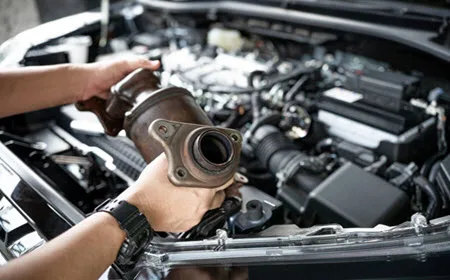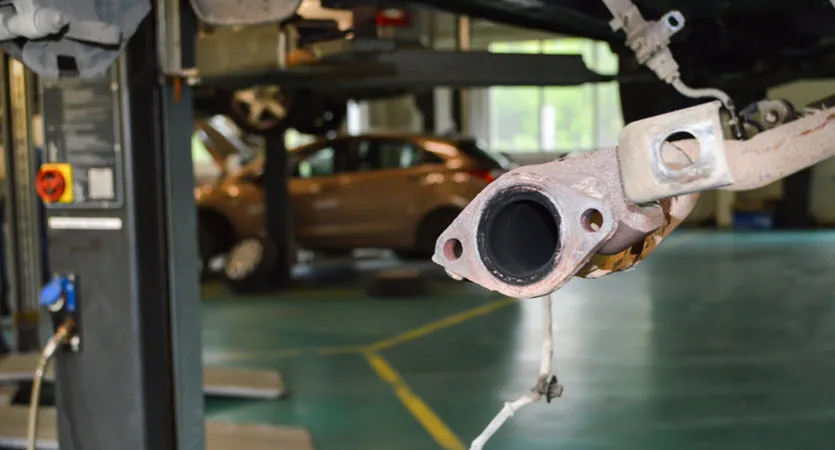Your Volvo’s exhaust system plays a vital role in the overall performance, efficiency, and environmental impact. While it might not be the flashiest aspect of your car, understanding how your exhaust system works and how to maintain it can lead to a smoother-running vehicle and potentially save you money on repairs.
What Does The Exhaust System Do?
- Emission Control: The first duty of the exhaust system is to protect the environment. This might sound contrasting because it actually emits waste gases. The exhaust system uses all its components to ensure that the harmful gases released are reduced to the barest minimum. Converting and filtering harmful gases helps curb air pollution and meet stringent emission standards set by regulatory bodies.
- Noise Reduction: The exhaust system’s contributions extend beyond emission concerns. It transforms the auditory landscape of the vehicle, suppressing the noise coming from the engine and replacing it with a more refined and subdued tone.
- Improved Engine Performance: It facilitates the smooth expulsion of exhaust gases and reduces backpressure. With unimpeded airflow, the engine can reach its optimal power and efficiency easily.
Components That Make Up The Exhaust System
Exhaust Manifold
The exhaust manifold serves as the gateway between the engine’s cylinders and the rest of the exhaust system. Positioned directly on the engine’s cylinder head, this component collects the scorching exhaust gases produced during combustion. Acting as a funnel, it channels these gases into a single pipe, kickstarting their journey through the exhaust system.
Constructed from sturdy materials like cast iron or stainless steel, the manifold withstands the extreme temperatures and pressures generated by the engine’s operation. Its design ensures that exhaust gases flow smoothly, minimizing back pressure and optimizing engine performance.
Catalytic Converter
A true environmental champion, the catalytic converter stands as one of the most significant advancements in exhaust system technology. This ingenious device harnesses chemical reactions to transform harmful pollutants into less noxious substances. As exhaust gases move through the catalytic converter, its internal catalysts trigger a series of chemical reactions that convert toxic nitrogen oxides to oxygen and nitrogen, carbon monoxide to carbon dioxide, and hydrocarbons to carbon dioxide and water.
This conversion process drastically reduces the emission of harmful gases into the atmosphere, contributing to cleaner air and better environmental health.
Muffler
The muffler takes on the role of a conductor, tempering the noise produced by the combustion process. Its primary duty is to disrupt and dissipate sound waves, effectively reducing exhaust noise.
Exhaust Pipes and Tubes
The pipes and tubes are responsible for guiding exhaust gases on their journey. These conduits are shaped to optimize flow, and transport gases from the manifold to the catalytic converter, then to the muffler, and finally to the tailpipe, where they are released into the atmosphere.
Oxygen Sensors
The exhaust system’s intelligence comes to life through the oxygen sensors. These small but essential components monitor the levels of oxygen in the exhaust gases and provide real-time data to the engine control unit to aid the adjustment of the air-fuel mixture delivered to the engine.
Common Exhaust System Issues
- Catalytic Converter Failure: Over time, the internal catalysts of the converter can degrade, leading to reduced efficiency and increased emissions. This can be exacerbated by the presence of contaminants in the fuel or oil.
- Exhaust Leaks: The system is subject to harsh conditions like exposure to moisture, road salt, and temperature fluctuations. These factors can cause corrosion, resulting in small holes or cracks in the pipes from which harmful gases leak.
- Muffler Damage: The muffler’s exposure to moisture and road debris can lead to rust and the development of holes. This deterioration impacts its noise-reduction capabilities, potentially resulting in a louder exhaust note.
- Oxygen Sensor Malfunction: Faulty oxygen sensors can provide inaccurate data to the ECU, leading to improper air-fuel mixture ratios. This can cause reduced fuel efficiency, poor engine performance, and increased emissions.
Trust Swedish Auto Service for Expert Volvo Care
If you notice any issues in your exhaust system,  take it to a qualified mechanic. At Swedish Auto Service, we are your best bet for Volvo repairs and maintenance. Our dedicated Volvo experts are equipped to carefully and precisely tackle any issue, including exhaust system problems. Over the years, we have assisted Volvo drivers from Cedar Park, Round Rock, Leander, and Austin, TX, and they trust the quality of our work. Your Volvo deserves nothing less than the best, and we’re here to deliver just that. Contact us today.
take it to a qualified mechanic. At Swedish Auto Service, we are your best bet for Volvo repairs and maintenance. Our dedicated Volvo experts are equipped to carefully and precisely tackle any issue, including exhaust system problems. Over the years, we have assisted Volvo drivers from Cedar Park, Round Rock, Leander, and Austin, TX, and they trust the quality of our work. Your Volvo deserves nothing less than the best, and we’re here to deliver just that. Contact us today.





